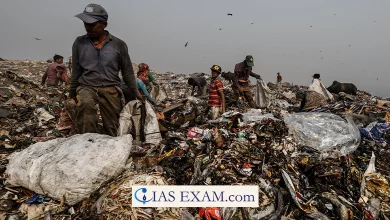World Bank: India Risks Demographic Dividend
Syllabus: Economics [GS Paper- 3]

Context
The World Bank has warned that South Asia, including India, isn’t capitalising on its demographic dividend. Job creation in the region isn’t keeping up with the growing working-age population. Despite this, the World Bank predicts strong growth of 6.0-6.1% for the region in 2024-25.
Key Points
- The export of South Asia has been growing, outperforming the other emerging and developing economies with the major contribution of the stock of India. In contrast, the rest of the area will have noteworthy expansion rates, with growth below the pre-pandemic levels.
- While public spending is still performing well as a driver of growth, private investment is still not attracting much attention. The region is susceptible to vulnerabilities, which can strongly affect growth prospects.
- Private investment growth has slowed in all South Asian countries, hindering development and climate goals.
- Limited fiscal positions make it challenging for public policies to support climate adaptation, placing the burden on firms, farmers, and households.
- South Asia’s labour markets have long suffered from declining employment ratios and low female employment participation.
- Non-agricultural sectors have been slow in creating jobs due to institutional and economic challenges.
- The region has relied on labour productivity and population growth for output growth, but both are expected to decelerate.
Details
Economic Growth vs. Employment Trends
- The South Asian economy is likely to expand at a rate of 6% to 6.1% in the coming fiscal year from March 2025, with India being the key driver of such growth.
- Nevertheless, the population in the region remains low in comparison with the increasing working age population even after such development.
- India has records parallel to Nepal in terms of employment lost between 2000 and 2022.
- The preliminary statistics of 2023 reveal a pallid improvement in that the Chief Economist of the World Bank on South Asia states that compared to the other low-income countries, the region had a higher employment rate.
Challenges and Recommendations
Sectors that are non-agricultural still have some towing employment patterns, as a result the business growth is facing the institutional headache and bad economic climate. The World Bank recommends several measures to encourage employment growth, including:
- Supporting the participation of women in the economy
- Increasing access to finance
- Increasing openness to trade
- Easing financial sector regulations
- Improving education
Demographic Dividend Opportunity
- The demographic dividend offers a unique opportunity for economic growth. When a country has a high proportion of working-age individuals, it can experience increased productivity and economic expansion.
- However, this potential can only be realised if these individuals are gainfully employed. The World Bank’s warning highlights the urgency of implementing policies that foster job creation, particularly in sectors that can absorb a large workforce.
India’s Role in the Region
- India with its large and youthful blown-up population, is a key player in the region’s future in terms of economy.
- The rapid economic growth of the country has been responsible for the fact that South Asia’s output growth has been far faster as compared to the other emerging market economies.
- The net result of all these factors still remains the employment challenge of India that needs to be bridged for upward economic mobility.
- The nation’s economic policies should be prioritised in creating the business enabling environment as well as job creation.
Way Forward
- Increasing job opportunities and loosening financial market regulations can help boost economic growth, attract private investments, and generate government revenue.
- Private investment tends to rise with strong institutional quality, competitive exchange rates, and open trade and capital flows.
- Public support is more effective than purely private strategies for climate adaptation.
- Sustaining growth requires increasing employment in non-agricultural sectors and among women, by removing barriers to business growth, promoting international trade, easing labour and product market restrictions, investing in human capital, and advancing gender equality.
Conclusion
The World Bank’s report serves as a call to action for South Asia, and India in particular, to take decisive steps towards harnessing the demographic dividend. By focusing on job creation and addressing the outlined challenges, the region can transform its demographic advantage into sustainable economic growth.
Source: The Hindu
UPSC Mains Practice Question
Q.Critically analyse the risks associated with India’s demographic dividend as highlighted by the World Bank. What policy measures should India undertake to mitigate these risks and harness its demographic potential effectively?





.png)



